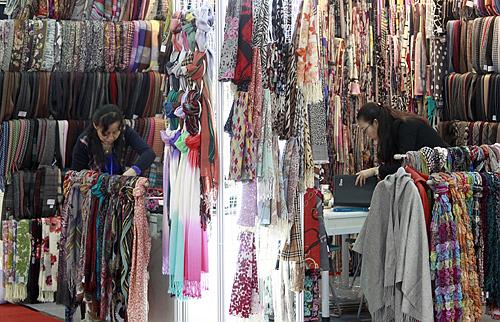|
 |
|
IT'S SHOW TIME: Exhibitors arrange their products at the 21st East China Fair, which is held in Shanghai from March 1-6 and attracts more than 3,300 exhibitors. Over 20,000 overseas buyers from various countries attended the trade fair (PEI XIN) |
Yuan Settlement
The People's Bank of China, the central bank, announced on March 2 that it would further expand trial yuan settlements in cross-border trade this year.
The market demand for yuan cross-border use is expected to climb, along with the increasingly close integration between China and the global economy.
China expanded the pilot program for yuan settlement in cross-border trade to 20 provincial regions last year.
The program was also expanded to about 67,000 exporters at the end of 2010, from the original 365.
China's banks handled 506.3 billion yuan ($77.06 billion) of cross-border trade settlements last year.
Green Targets
The amount of energy consumed for per unit of GDP fell 4 percent last year from its 2009 level, according to calculations by the National Bureau of Statistics.
Between 2006 and 2010, the country achieved a 19.1-percent drop in energy intensity, roughly meeting its five-year target to improve energy efficiency by 20 percent, Premier Wen Jiabao said on February 27 during an online conversation with netizens.
Wen also unveiled new goals to bring down both energy consumption and carbon dioxide emissions per unit of GDP by 16 to 17 percent from 2011 to the end of 2015.
China-ASEAN Investment
China's direct investment to Association of South-East Asian Nations (ASEAN) countries stood at around $2.57 billion in 2010 since the China-ASEAN Free Trade Area was opened a year ago, said Sun Yuanjiang, an official from the Ministry of Commerce.
Over the past year, tariffs on trade between China and ASEAN countries have been sharply reduced. Now 90 percent of goods traded between both sides enjoy zero duties, Sun said.
In 2010, direct investment from ASEAN countries to China reached $6.32 billion, an increase of 35.2 percent.
Shanghai's Ranking
Shanghai is now ranked No. 1 in terms of comprehensive economic competitiveness among China's provinces and municipalities, according to a survey released on February 28 by the Chinese Academy of Social Sciences.
The city is followed by Beijing Municipality and Jiangsu Province.
"The established infrastructure and the great policy support to build Shanghai into a global financial center are the city's strengths in economic development," said Li Maoyu, an analyst of Changjiang Securities Co.
Developer's Record
Poly Real Estate Group Co. Ltd., China's second largest property developer by market value, said on March 1 in its annual report that its 2010 net profit soared 39.8 percent from one year earlier to 4.92 billion yuan ($748 million).
Turnover stood at 35.9 billion yuan ($5.46 billion), up 56.15 percent year on year, said the company report.
Poly's nationwide market share increased to 1.35 percent from 1.3 percent in 2009, while total assets jumped 69.57 percent to 152.33 billion yuan ($23.18 billion).
Poly said that it expects "fluctuations" in China's property market this year, and the company has made full preparation for it. | 